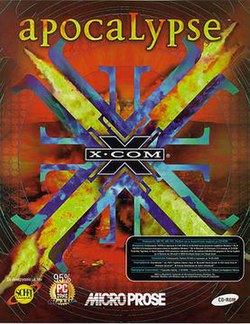X-COM: Apocalypse
| X-COM: Apocalypse | |
|---|---|

European cover art
|
|
| Developer(s) | Mythos Games |
| Publisher(s) | MicroProse |
| Distributor(s) | MicroProse Hasbro Interactive 2K Games |
| Designer(s) |
Julian Gollop Tim White |
| Programmer(s) | Nick Gollop Dave Bostock Thaddaeus Frogley |
| Composer(s) |
John Broomhall Richard Wells |
| Series | X-COM |
| Platform(s) | DOS and Microsoft Windows |
| Release | June 30, 1997 |
| Genre(s) | Turn-based tactics, real-time tactics |
| Mode(s) | Single player |
X-COM: Apocalypse is the third game in the X-COM video game series. It was developed by Mythos Games (the creators of the original X-COM game), and published by MicroProse in 1997 for DOS and Microsoft Windows.
Similar to the first two X-COM games, Apocalypse features a map-like management mode (the Cityscape) and an isometric combat mode (the Battlescape). The management mode takes place in a single city, called Mega Primus, rather than being spread out over the entire planet Earth as in the previous games. In addition, Apocalypse was the first game in the X-COM series to include a real-time combat option as well as the traditional turn-based mode.
Apocalypse features a re-done interface with new graphics. It is more complex, and the task of keeping and increasing the funding of the X-COM organization now extends to not only intercepting UFOs, but also to minimizing collateral damage, preventing alien hostile takeovers and even raiding the buildings of other organisations, of which there are several in Mega Primus. A new feature is the choice of playing the tactical missions in either the familiar turn-based mode or real-time. In the turn-based mode, the aliens and humans switch turns to perform actions while in real-time, everything happens simultaneously, though the game can be paused at any time to issue orders to agents.
X-COM: Apocalypse claims to have a self-learning AI-module. The game does feature self-adjusting difficulty, where player performances influences the Alien zeal to expand and infest. Sluggish X-COM responses, total failures, and a bad weekly rating slow the alien build-up of weapons and creatures (but not ships) on their homeworld. This gives the player the chance to amend their failures and rethink their strategy. For example, a high rating in first five days can make the Aliens attack your HQ head-on with a large heavily armed mob often. Conversely, a low rating in the first five days can make the aliens only incur twice a week, with a very small force. This also affects the equipment quality of the aliens, so if a very high score is acquired quickly (for example by using a bug that allows the player to raid allied organisations without hostile response), the very first batch of aliens might be found with personal shields and disruptor cannons (which normally would appear only much later in the game).
...
Wikipedia
